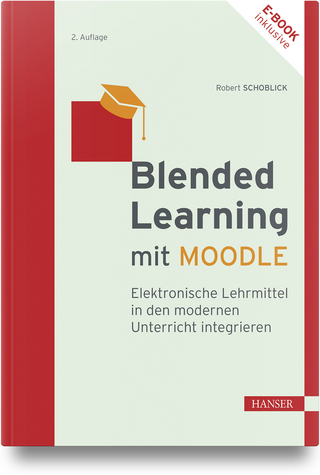
Intersections Across Disciplines
Springer International Publishing (Verlag)
978-3-030-53874-3 (ISBN)
This volume is the result of the annual Summer research symposium sponsored by the Association for Educational Communications and Technology (AECT). The twenty-two chapters in this volume seek to examine how learning and the design of instruction is interdisciplinary and connective in terms of research and practice.
The book is generally divided into three areas: Theory, Research, and Application. This framework shaped the authors' interactions, discussions, and the informal context of the symposium. Writings are included on multiple levels including research and practice on learning across disciplines, including instructional design and how design thinking is inherently interdisciplinary. How learning is designed for general audiences or for purposely integrated educational experiences has also been examined.
Brad Hokanson is a professor in Graphic Design at the University of Minnesota. He has a diverse academic record, including degrees in art, architecture, urban design, and received his Ph.D. in Instructional Technology. He teaches in the area of creative problem solving and has published research in the fields of creativity and educational technology. His most recent book is Developing Creative Thinking in Learners. He also currently is the Mertie Buckman Professor of Design Education. He won his colleges' awards for outstanding teaching in 2002 and 2008. He has recently completed research on the relationship between creativity and achievement in school children, comparing measured creativity with standardized achievement scores. He is now running his fourth massive online course on creativity for the University of Minnesota with an enrollment of over 143,000. Previous courses each enrolled over 52,000 learners. He served as President of the Association of Educational Communication and Technology in 2017. He has led the Summer Research Symposium since 2012, and has served as lead editor of the books for the last four volumes published with Springer.
Chapter 1. Rethinking the Role of the Library in an Era of Inquiry-based Learning: Opportunities for Interdisciplinary Approaches.- Chapter 2. Guiding Principles for Integrating Disciplines and Practices in Pursuit of Complex and Diverse Learning Outcomes.- Chapter 3. Educology Is Interdisciplinary: What Is It? Why Do We Need It? Why Should We Care?.- Chapter 4. Multimodal Social Semiotics and Learning Design: In Search of Interdisciplinarity.- Chapter 5. Wisdom and Power: Using Information Theory to Assess the Transactional Relationship between the Learner and the Knowledge Provider.- Chapter 6. The Importance of Interest Development across STEM Learning Environments .- Chapter 7. Designing for Generative Online Learning: A Situative Program of Research.- Chapter 8. Instructional design and user experience design: Values and perspectives examined through artifact analysis.- Chapter 9. Educational Software Design in Practice: Understanding the Power of Intersecting Disciplines on Design Process .- Chapter 10. Unifying Material Culture and Traditional Research: How Academic Museums Stimulate Interdisciplinary Experiences for Faculty.- Chapter 11. Improving Reading Speed for Dyslexic Readers.- Chapter 12. Interdisciplinary Research Collaboration: An Option for Advancing Your "Unpublishable" Research.- Chapter 13. The Centrality of Interdisciplinarity for Overcoming Design and Development Constraints of a Multi-user Virtual Reality Intervention for Adults with Autism: A Design Case.- Chapter 14. Potentials of Teaching, Learning, and Design with Virtual Reality: an Interdisciplinary Thematic Analysis.- Chapter 15. Cultivating Design Thinking in an Interdisciplinary Collaborative Project-based Learning Environment.- Chapter 16. Reframing Interdisciplinarity Toward Equity and Inclusion.- Chapter 17. Interdisciplinary Development of Geoscience OER:Formative Evaluation and Project Management for Instructional Design.- Chapter 18. Muse Design Studio: Advancing Creative Problem Solving as a Platform for Interdisciplinary Education.- Chapter 19. Interdisciplinarity and International Education: Creating Opportunities for Collaboration in Design Research and Practice.- Chapter 20. Developing a Rubric for Teaching and Assessing Design Thinking Across the Curriculum.- Chapter 21. Teaching Design to Public Health Majors: A Design Case of an Undergraduate Interdisciplinary Course.- Chapter 22. Interdisciplinary Learner Engagement: Bridging Corporate Training and K-12 Education.
| Erscheinungsdatum | 17.12.2020 |
|---|---|
| Reihe/Serie | Educational Communications and Technology: Issues and Innovations |
| Zusatzinfo | XI, 303 p. 70 illus., 55 illus. in color. |
| Verlagsort | Cham |
| Sprache | englisch |
| Maße | 155 x 235 mm |
| Gewicht | 641 g |
| Themenwelt | Schulbuch / Wörterbuch ► Unterrichtsvorbereitung ► Unterrichts-Handreichungen |
| Geisteswissenschaften ► Psychologie ► Pädagogische Psychologie | |
| Sozialwissenschaften ► Pädagogik ► Erwachsenenbildung | |
| Sozialwissenschaften ► Pädagogik ► Schulpädagogik / Grundschule | |
| Schlagworte | Application of interdisciplinary research • Educational software design • Educational technology • Improving reading speed for dyslexic readers • inquiry-based learning • Interdisciplinary curriculum design • Interdisciplinary education • interdisciplinary learning • Teaching and assessing design thinking • Theory of interdisciplinary education • transdisciplinary education |
| ISBN-10 | 3-030-53874-5 / 3030538745 |
| ISBN-13 | 978-3-030-53874-3 / 9783030538743 |
| Zustand | Neuware |
| Haben Sie eine Frage zum Produkt? |
aus dem Bereich


